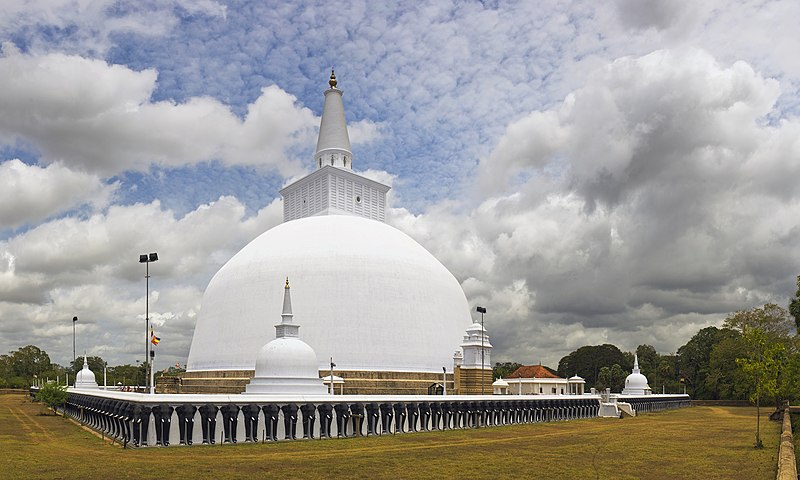OB03057 Ruvanväli-Dāgaba Slab of Kīrti-Niśśaṅka-Malla
IN03077 Ruvanväli-Dāgaba Slab Inscription of Kīrti-Niśśaṅka-Malla
The inscription is engraved on the side of a fixed slab, which stands erect in a bed of brickwork, flanked by two monolithic pillars, within a few yards of the statues near the eastern altar of the Ruvanväli-dāgaba in Anurādhapura. It was discovered in 1874 by Nāranviṭa Thēra. The inscription consists of 35 lines in the Sinhalese alphabet of the twelfth and thirteenth centuries. It dates from the reign of Kīrti-Niśśaṅka-Malla (1187-1196 A.D.) and gives a general account of his various philanthropic and religious acts, mostly in Poḷonnaruva, his state visit to Anurāpura in his fourth regnal year, the lavish manner in which he worshipped the Ruvanväli-dāgaba there, and the steps he took to restore the Mīrisaviṭiya and other vihāras.
OB03056 Ram̆bǟva Slab Inscription
IN03076 Ram̆bǟva Slab Inscription
The inscription consists of 39 lines engraved on the ruled surface of a stone slab. It was discovered in 1892 by the Archaeological Commissioner (Mr. H.C.P. Bell) a hundred years south of the ‘Cooly Shelter’ at Ram̆bǟva (Rambewa) and subsequently moved to Anurādhapura. Wickremasinghe describes Ram̆bǟva as a well-known village in Kǟn̆dǟ-kōrale at the junction of the two main roads from Anurādhapura and from Mihintale, about nine miles north-east of the former town. The inscription is dated to the first year of the reign of king Siri Saňg-bo Abhā, identified by Wickremasinghe with Mahinda IV. It records a grant of lands and immunities to one Kiliňgu-ra Pirivat Hämbuvan, to be held by him and his descendants for the purpose of supplying oil to illuminate the stone image of the Buddha at the Sacred Bōdhi-tree.
OB03055 Mayilagastoṭa Pillar
IN03075 Mayilagastoṭa Pillar Inscription
The inscription is engraved on three sides of a quadrangular pillar. It was discovered sometime in or before 1876 by J. H. Dawson, an Irrigation Officer, at Mayilagastoṭa, a village about 8 miles from Tissamahārāma in the Hambantoṭa district. The pillar was afterwards brought afterwards to the Colombo Museum. The first and second sides of the pillar each feature 35 lines written in the Sinhalese alphabet of the tenth or early eleventh century A.D. Further lines are inscribed on the third side of the pillar but they are now illegible. The inscription records the dedication of certain lands and a grant of immunities to Uḍa-Tisa-pirivena, situated near Mahagama on the left bank of Kirind-ho. No date is given in the inscription but it is described as having been issued by the ǟpā Mihindu, who subsequently became king Mahinda IV. The use of the title ǟpā indicates that the grant was made in the early part of this king’s career, when he was a mere governor. This record has been useful for identifying Mahinda IV of the Mahāvaṁsa with Siri Saňg-boy Abahay of the Mihintale tablets (IN03030).
OB03054 Poḷonnaruva Raja-Māḷigāva Pillar of Mahinda IV
IN03074 Poḷonnaruva Raja-Māḷigāva Pillar Inscription of Mahinda IV
The inscription is engraved on three sides of a quadrangular pillar, which was discovered in or before 1905 at the site of the so-called Raja-māḷigāva (royal palace) in the Citadel of Poḷonnaruva. In 1912, Wickremasinghe reported that the pillar had been moved to the premises of the Archaeological Commissioner at Tōpa-väva. The inscription consists of 118 lines in the Sinhalese alphabet of the early eleventh century A.D. It is dated to the eighth year of the reign of king Siri San̆g-bo and records the granting of immunities to a village called Kiṇigama, belonging to Kuḷu-Tisa-rad-maha-vehera of the Mahāvihāra Nikāya, situated in the Eastern Quarter. Wickremasinghe suggests that the biruda Siri San̆g-bo refers in this instance to Mahinda IV. The first three lines of the inscription are almost word-for-word identical with the two slab inscriptions of Mahinda IV at Jētavanārāma (IN03061 and IN03062).
OB03053 Äṭavīragollǟva Pillar
IN03073 Äṭavīragollǟva Pillar Inscription
The inscription is engraved on a pillar which was found lying by the side of the pin-pāra, the village-road of Äṭavīragollǟva, about eleven miles from Madawacci in Kaḍawat Kōrale. It was first read by Dr. Goldschmidt and then by Dr. Müller, who published a rough transcript, with a translation of the first side only, in 1883. The Archaeological Commissioner, H. C. P. Bell, re-examined it in 1890. Engraved on four sides of a quadrangular pillar, the inscription is written in the Sinhalese alphabet of the 10th century A.D. The stone is split at the top, resulting in the obliteration of several lines of the inscription on the first and fourth sides of the pillar. The inscription is dated to the tenth year of the reign of king Abhā Salamevan and records a grant of immunities to the village Velangama belonging to the Sirisan̆gbo-rad-pirivena (possibly the Sirisaṅghabōdhi-parivēṇa built by Aggabōdhi I in the 7th century A.D.). From the inscription, we also learn that Abhā Salamevan was the son of the king Abhā Siri Saňg-bo, who ransacked the Pāṇḍya country and obtained a victory in the ninth year of his reign. Here, the biruda Abhā Siri San̆g-bo refers to Sēna II, whose son was Kassapa IV. However, Wickremasinghe identifies the Abhā Salamevan in this inscription with Dappula V, a grandson of Sēna II. Either Wickremasinghe is mistaken in this identification or the inscription should read ‘grandson’ instead of ‘son’.

